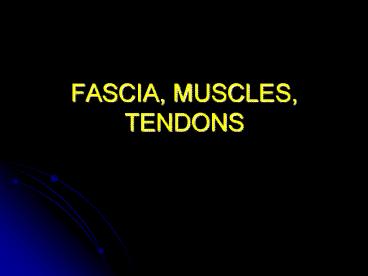FASCIA, MUSCLES, TENDONS PowerPoint PPT Presentation
1 / 38
Title: FASCIA, MUSCLES, TENDONS
1
FASCIA, MUSCLES, TENDONS
2
Skeletal Muscle Structure
- Origin
- Proximal attachment
- Insertion
- Distal attachment
- Tendons
- Peritendineum
- Aponeurosis
3
Skeletal Muscle Hierarchy
- Myofilament
- Thick filaments
- Myosin
- Thin filaments
- Actin
- Myofibril
- Bundle of myofilaments
- Segmentally arranged into sarcomeres
4
Skeletal Muscle Hierarchy
- Myofiber
- Made up of many myofibrils
- Multinucleated in skeletal muscles
- muscle cell
- Fascicle
- Bundle of myofibers
- Muscle
- Composed of several to several hundred
fascicles
5
Connective Tissues
- Endomysium
- Surrounds a myofiber
- Perimysium
- Surrounds a fascicle
6
Connective Tissues
- Epimysium
- Covers entire muscle
- Blends in with deep fascia
- Connective tissue supports provide physical
support and a pathway for nerves and vessels.
7
(No Transcript)
8
Myofilaments
- Actin myofilaments (F-actin)
- Polymers of G-actin
- Tropomyosin
- Troponin
- Myosin filaments
- ATPase
9
Sarcomeres
- Z-line (Z-actin)
- Composed of Z-actin
- Marks ends of Z-actin
- I bands
- Part of a sarcomere composed entirely of actin
10
Sarcomeres
- A band
- Part of a sarcomere composed of both actin and
myosin - H band
- Part of a sarcomere composed entirely of myosin
11
Sliding Filament Theory
- During a contraction
- I band and H band shorten
- A band remains the same length
- Sliding occurs when ATPase heads of myosin attach
to actin via troponin and swivel.
12
(No Transcript)
13
(No Transcript)
14
Myofiber
- Sarcoplasmic reticulum
- Equivalent to endoplasmic reticulum of most
cells. - T-tubules
- Tubular extensions of the muscle fiber
membrane that extend down into the cytoplasm
(saracoplasm). - Conduct action potential from cell membrane
surface to interior.
15
Myofiber
- Cisternae
- Saccular extensions of the sarcoplasmic
reticulum that release calcium ions in response
to action potential. - Calcium ions trigger sliding of myosin and
actin filaments, resulting in a contraction.
16
(No Transcript)
17
Myofiber Type
- The myofiber type (red or white) depends on
innervation. - All myofibers in a motor unit are of the same
type.
18
Dark (red) Fibers
- Fatigue resistant
- Contract slowly (slow twitch)
- Rely on oxidative phosphorylation
- Have a large number of mitochondria
- Have a high concentration of myoglobin
- Have a low concentration of ATPase
19
Light (white) Fibers
- Fatigue easily
- Contract rapidly (fast twitch)
- Rely on glycolysis
- Have a small number of mitochondria
- Have a low concentration of myoglobin
- Have a high concentration of ATPase
20
Neuromuscular Junctions
- Components
- Presynaptic membrane
- Terminal end of motor neuron.
- Synaptic cleft
- Postsynaptic membrane
- Sarcolemma (cell membrane of myofiber)
21
Motor Unit
- Consists of a motor neuron and all the myofibers
it innervates - Units for fine control have fewer fibers
- Units for gross control have many fibers
22
(No Transcript)
23
Muscle Classification
- Fiber arrangement
- Shape
- Origin and insertion
- Function
24
Fiber Arrangement
- Straight
- Example rectus abdominis
- Fusiform
- Example biceps brachii
- Unipennate
- Example palmar interosseous muscles
- Bipennate
- Example dorsal interosseous muscles
- Multipennate
- Example deltoid muscle
25
(No Transcript)
26
Muscle Shape
- Deltoid
- Trapezius
27
Muscle Origin/Insertion
- Coracobrachialis
- Sternocleidomastoid
28
Muscle Function
- Pronater teres
- Extensor digitorum
29
Contraction
- Definition
- A contraction is a muscles response to a
stimulus. - Types of contraction
- Isotonic (the length of the muscle changes)
- Concentric (length decreases)
- Eccentric (length increases)
- Isometric (the length of the muscle stays the
same)
30
Types of Action
- Agonist (prime mover)
- A muscle that primarily carries out the
desired action. - Antagonist
- A muscle that opposes the agonist.
- Synergist
- A muscle that eliminates the unwanted action
of the agonist.
31
Types of Action
- Fixator
- A muscle that stabilizes the origin of another
muscle. - Note a single muscle can be all the above at one
time or another.
32
Insufficiency
- Refers to the inability of a multijoint muscle to
maximally contract simultaneously over all joints
crossed. - Active
- Refers to the agonist
- Passive
- Refers to the antagonist
33
Smooth Muscle
- Synonyms
- Visceral
- Involuntary
- Found in
- Walls of visceral tubes (intestines, etc.)
- Associated with hair follicles
- Around glandular structures
- In walls of blood vessels
34
Smooth Muscle Characteristics
- Bundles of sheets of individual cells.
- Not striated (smooth).
- Cells are primarily elongated and tapered.
- Mononucleated.
35
Smooth Muscle Characteristics
- Nuclei are centrally located in each cell.
- Does not conduct action potential.
- Cells connected by gap junctions.
- Not under voluntary control.
36
(No Transcript)
37
Cardiac Muscle Tissue
- Found only in walls of heart.
- Characteristics
- Striated (sarcomeres)
- Mononucleated cells
- May branch
- Intercalated discs
- Sites of transfer of stimulus between adjacent
cells.
38
(No Transcript)

